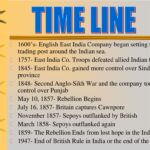Embark on an enlightening journey through the annals of time as we unveil the grandeur of India’s past in “A Brief History of India: Unveiling the Grandeur of India’s Past.” From ancient civilizations to mighty empires and the vibrant tapestry of culture, this article delves into the fascinating narrative that has shaped one of the world’s oldest and most diverse nations.
Key Takeaways:
- India gained independence in 1947, resulting in the partition of the subcontinent into India and Pakistan.
- The nation’s population reached the milestone of one billion in 1998.
- Prime Minister Indira Gandhi was assassinated in 1984, prompting the rise of her son, Rajiv Gandhi.
- Under the leadership of Prime Minister Indira Gandhi, the Congress party regained power in 1980.
- In 1998, India conducted nuclear tests, leading to international sanctions.
A Brief History of India

Ancient India: The Cradle of Civilization
– India’s history dates back to the Indus Valley Civilization, one of the world’s earliest and most advanced civilizations, flourishing around 2500 BC.
– Cities like Harappa and Mohenjo-Daro showcased remarkable town planning, engineering, and art.
The Vedic Age: The Foundation of Hinduism
– Around 1500 BC, the Aryans, nomadic tribes from Central Asia, entered the Indian subcontinent, bringing with them the Vedic culture and Hinduism.
– The Vedas, a collection of sacred texts, laid the foundation of Hindu philosophy, mythology, and rituals.
– The caste system, a social hierarchy, emerged during this period, influencing Indian society for centuries.
The Mauryan Empire: India’s Golden Age
– In the 4th century BC, Chandragupta Maurya founded the Mauryan Empire, which stretched across most of the Indian subcontinent.
– Ashoka, Chandragupta’s grandson, embraced Buddhism and promoted non-violence, leaving behind a legacy of peace and prosperity.
The Rise and Fall of Empires
– After the Mauryas, India witnessed the rise and fall of several empires, including the Gupta Empire (4th-6th century AD), the Delhi Sultanate (13th-16th century), and the Mughal Empire (16th-18th century).
– These empires left behind magnificent monuments, such as the Taj Mahal, and contributed to India’s rich cultural heritage.
The British Raj and the Freedom Struggle
– In the 18th century, the British East India Company gained control over large parts of India.
– The Indian independence movement, led by iconic figures like Mahatma Gandhi, fought for freedom from British rule.
– In 1947, India achieved independence, but it came with the painful partition into India and Pakistan.
Modern India: A Nation on the Rise
– Post-independence, India adopted a democratic constitution and embarked on a journey of economic and social development.
– Despite challenges, India emerged as one of the world’s fastest-growing economies, with a vibrant democracy and a diverse cultural landscape.
India’s history is a grand tapestry of diverse cultures, empires, and civilizations, leaving an indelible mark on the world stage. It is a land where ancient traditions coexist with modern aspirations, a nation that continues to captivate and inspire.
- Learn the history of airways’s presence in India.
- Explore the lineage of the Alaskan Malamute, a breed revered for its strength and endurance here.
British Colonial Rule: Colonization by the British Empire profoundly impacted India, introducing Western influences, establishing an administrative system, and triggering the Indian independence movement.
The Power Play
Imagine a game of chess where the British Empire makes its move in 1757, securing victory at the Battle of Plassey, and establishing its dominance over India for the next 200 years. This period, aptly termed the British Raj, left an indelible mark on the subcontinent.
Exploitation and Influence
The British, with their imperial might, indulged in various forms of exploitation in India, from extracting resources to imposing unfavorable trade policies. It’s like a farmer exploiting his crops for personal gain. However, they also inadvertently introduced Western influences, impacting India’s economy, society, and culture, much like a gardener introducing new seeds into a garden.
Trade and Industry
The traditional Indian economy, vibrant and diverse, was transformed into a subservient cog in the British machinery. India became a supplier of raw materials, while British industries flourished, akin to a puppeteer controlling the movements of a marionette. Traditional Indian industries, once thriving, withered away, unable to compete with the might of the Empire.
Land and Taxation
The British reshaped the land tenure and taxation systems, impoverishing the Indian peasantry, who were already struggling to make ends meet. Imagine a heavy burden placed on their shoulders, making it almost impossible to rise.
Social Hierarchy
The British introduced a rigid social hierarchy based on race, relegating Indians to a subordinate status. It was a tale of two worlds, with the British elite enjoying privileges and Indians facing discrimination and limited opportunities.
Education and Culture
Amidst the exploitation, the British also introduced Western education and culture, creating a new class of Indians who embraced these influences. It was a double-edged sword, with Indians gaining knowledge but also grappling with the erosion of their traditional values.
Key Takeaways:
The Battle of Plassey in 1757 marked the beginning of British rule in India, lasting for about 200 years.
British rule led to the exploitation of India’s resources, forced labor, and unequal trade policies.
The traditional Indian economy was transformed into a сырьевой придаток, focused on cash crops for export, while indigenous industries declined.
The British introduced new land tenure and taxation systems, impoverishing the Indian peasantry.
A rigid social hierarchy based on race was imposed, with Indians facing discrimination and limited opportunities.
Western education and culture were introduced, creating a new class of Indians who embraced these influences.
The British Raj ultimately triggered the Indian independence movement, leading to India’s independence in 1947.
The Independence Movement: Led by iconic figures like Mahatma Gandhi and Jawaharlal Nehru, the nonviolent resistance movement strived to liberate India from British rule, achieving independence in 1947.

The Indian independence movement, a pivotal chapter in India’s history, was a remarkable struggle for freedom marked by nonviolent resistance and the indomitable spirit of its people. This movement, led by Mahatma Gandhi and Jawaharlal Nehru, played a crucial role in liberating India from British colonial rule.
The Rise of Indian Nationalism
The seeds of Indian nationalism were sown as a reaction to British rule and its oppressive policies. The Indian National Congress, founded in 1885, became the epicenter of the nationalist movement. It aimed to foster unity among Indians and advocated for self-governance.
Mahatma Gandhi’s Nonviolent Resistance
Mahatma Gandhi, the revered leader of the independence movement, espoused the philosophy of nonviolent resistance, or satyagraha. Gandhi’s teachings, based on truth and nonviolence, resonated with millions of Indians, who joined his cause.
Khilafat Movement and Non-Cooperation Movement
In 1919, following World War I, the Khilafat Movement emerged, seeking to protect the rights of Indian Muslims. Gandhi saw this as an opportunity to unite Hindus and Muslims in the struggle for independence. He launched the Non-Cooperation Movement in 1920, urging Indians to boycott British goods, institutions, and elections.
The Salt Satyagraha
In 1930, Gandhi led the Salt Satyagraha, a mass civil disobedience movement against the British salt monopoly. Thousands of Indians participated in the march to the coastal village of Dandi, defying the British salt laws.
The Quit India Movement
In 1942, as World War II intensified, Gandhi called for the Quit India Movement, demanding complete independence from British rule. This resulted in the arrest of Gandhi and other leaders, leading to widespread protests across India.
The Road to Independence
After years of struggle and negotiations, India finally achieved independence on August 15, 1947. The British Raj came to an end, and India embarked on a new journey as a sovereign nation.
Key Takeaways:
Nonviolent Resistance: Mahatma Gandhi’s philosophy of nonviolent resistance, or satyagraha, was a defining characteristic of the Indian independence movement.
Unity and Nationalism: The movement brought together people from diverse backgrounds, fostering a sense of unity and nationalism among Indians.
Civil Disobedience: Mass civil disobedience movements, such as the Non-Cooperation Movement and the Salt Satyagraha, played a crucial role in challenging British authority.
Iconic Leaders: Mahatma Gandhi and Jawaharlal Nehru emerged as iconic leaders who inspired and mobilized millions to join the freedom struggle.
Global Impact: The Indian independence movement became an inspiration for anti-colonial movements around the world, demonstrating the power of nonviolent resistance.
Sources:
Modern India: Following Independence, India embraced Democracy, Faced Challenges such as Poverty and Religious Tensions, and Emerged as a Prominent Player in Global Affairs, Notably in Technology and Space Exploration.
Post-Independence Challenges:
Following independence in 1947, India faced several challenges on its path to progress. Extreme poverty, fueled by a rapidly growing population, remained a persistent issue. The partition of India and Pakistan led to religious tensions and the displacement of millions of people. These challenges tested the resilience of India’s fledgling democracy.
Poverty and Economic Development:
India embarked on ambitious economic development plans to alleviate poverty, aiming to modernize and industrialize the country. While India achieved significant economic growth, poverty remained a pervasive issue, particularly in rural areas. The Green Revolution, introduced in the 1960s, brought significant improvements to agricultural productivity and helped reduce food shortages.
Religious Tensions:
India’s diverse religious landscape led to occasional outbreaks of communal violence and tensions. The demolition of the Babri Masjid in 1992 triggered widespread riots and highlighted the need for interfaith dialogue and understanding. India’s secular constitution and the efforts of its citizens have helped foster tolerance and coexistance among different religions.
Global Affairs:
Despite its challenges, India emerged as a prominent player in global affairs. Its non-aligned stance during the Cold War earned it respect and recognition. India became a founding member of the Non-Aligned Movement, advocating for peace and cooperation among nations. In recent decades, India’s economic and technological advancements have solidified its position as a key player in global trade and innovation.
Technological Advancements
India’s technological prowess is a source of pride and global influence. Its expertise in the IT sector has made it a hub for software development and outsourcing. The country’s space exploration program has achieved remarkable successes, with missions like Chandrayaan-1 and Mangalyaan showcasing India’s scientific capabilities.
Key Takeaways:
- Post-independence India faced the challenges of poverty, religious tensions, and the need for economic development.
- India’s democracy proved resilient in addressing these challenges and promoting progress.
- The Green Revolution brought significant improvements to agricultural productivity and helped reduce food shortages.
- India’s role in global affairs is characterized by its non-aligned stance and its emergence as a technology and space exploration leader.
Sources:
- Modern India: Challenges and Achievements
- India – History
FAQ
Q1: Did the British presence leave a lasting impact on India’s society and culture?
A1: Indeed, the British rule left a profound impact on India’s society and culture. They imposed a hierarchical system based on race and introduced Western education and culture, which significantly influenced the country’s intellectual and cultural landscape.
Q2: Who played a crucial role in leading India’s independence movement?
A2: Mahatma Gandhi played a pivotal role in leading the Indian independence movement. He championed nonviolent civil disobedience and civil resistance, organizing movements such as the non-cooperation movement and the civil disobedience movement, which contributed significantly to India’s eventual independence.
Q3: What challenges does India’s democracy face?
A3: Despite being the world’s largest democracy, India faces several challenges in delivering sustained economic development and eliminating extreme poverty. It also grapples with issues such as corruption, caste discrimination, and ethnic and religious tensions.
Q4: How did the Battle of Plassey shape India’s history?
A4: The Battle of Plassey in 1757 marked a significant turning point in Indian history. The British victory in this battle laid the foundation for the establishment of the British Empire in India, leading to a period of colonial rule that lasted for over 200 years and profoundly impacted the country’s political, economic, and social fabric.
Q5: When did India achieve independence?
A5: India gained its independence from British rule on August 15, 1947, after a long and arduous struggle for freedom. Jawaharlal Nehru became the country’s first Prime Minister, and India embarked on a new journey as an independent nation.
- China II Review: Delicious Food & Speedy Service - April 17, 2025
- Understand Virginia’s Flag: History & Debate - April 17, 2025
- Explore Long Island’s Map: Unique Regions & Insights - April 17, 2025
















